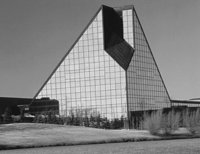Royal Canadian Mint
|
|
CanadianMintLogo.jpg
The Royal Canadian Mint produces all of Canada's circulation coins, and manufactures circulation coins on behalf of other nations. The Mint designs and manufactures: collector coins; gold, silver and platinum bullion coins; customized medals, tokens and trade dollars; and watches and jewellery featuring coin designs. It also offers gold refinery and assay services.
The President and Master of the Mint is the senior executive officer of the organization, reporting to a Board of Directors appointed by the Minister of Public Works and Government Services. The Mint operates under the legislative basis of the Royal Canadian Mint Act.
The Mint has been at the forefront of currency innovation. Among the Mint's technical innovations was the world's first coloured circulation coin, the 2004 Remembrance Day 25-cent piece, with a red poppy on the reverse.
Many foreign countries have had coinage struck at the Royal Canadian Mint.
History
The Ottawa branch of the Royal Mint was formed in 1908. Prior to the Royal Mint opening up in Ottawa, Canada's currency was solely produced in Great Britain at the Royal Mint and the Heaton Mint. After the Ottawa branch opened, it allowed Canada to create their own coinage and create coinage for many other nations/territories including Newfoundland. The first coin to be produced at the new facility was the 50 cent coin on January 2 1908.
During the years following its opening, the mint offered collector coin sets. Most of these sets today are worth thousands of dollars. During World War 1, when there was a large demand for silver and copper, there were a few years when very few coins were produced.
In 1931, the Royal Mint was made a Canadian government corporation and renamed Royal Canadian Mint. As the Ottawa Mint was now Canadian owned, the mint was no longer allowed to produce gold sovereign coins. World War 2 and the Korean War saw the low mintages of most of their coinages, as well as the first time using tombac in the 5 cent coin.
In 1967, the mint introduced a series of commemorative coins in honour of the Canadian centennial, every coin produced that year featured a creature that is native to Canada. This was the last year that all circulation coins from the 10 cent coin to the 1 dollar coin contained 75% silver.
In 1971, the mint re-introduced the silver dollar to collectors with the centennial of British Columbia, this dollar was also featured in a hard-bound coin set for the first time. In 1976, the Winnipeg branch of the Royal Canadian Mint opened, allowing Ottawa to concentrate souly on collector coins while the Winnipeg mint would produce the entire supply of circulation coins to date.
Since then, the Royal Canadian Mint has received many awards for innovations in technology and quality. The Royal Canadian Mint created the world's first circulation colour coin in 2004, featuring a red poppy in honour of Remembrance Day, as well as helping in the creation of the coin blanks of the Sacagawea dollar for the United States Mint.
See also
External links
- Royal Canadian Mint Official Website (http://www.mint.ca)
- Royal Canadian Mint Act (http://laws.justice.gc.ca/en/R-9/text.html)
- Canadian Numismatic Association (http://www.canadian-numismatic.org/)
- Numismatic Network Canada (http://www.nunetcan.net)
- Canadian Coin News (http://www.canadiancoinnews.ca/)
- Homepage for the Red Poppy Quarter (http://www.mint.ca/poppy/default.asp)


